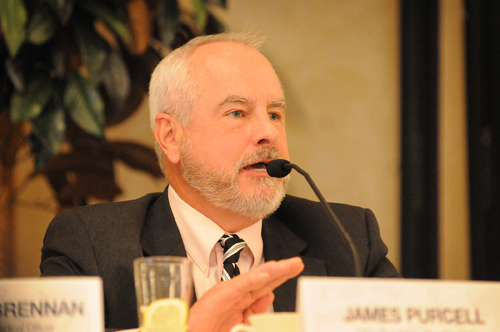
It’s not easy being Blue Cross & Blue Shield of Rhode Island these days.
Despite collecting a record $1.7 billion in premiums in 2009, the nonprofit insurer lost $100 million for the year, and it saw its reserves dwindle to $558 per member, down from $713 in 2008. By the end of 2010, reserves are expected to drop to $479 per member.
In the Direct Pay market, which only Blue Cross serves, the company was denied any rate hikes last year, and for 2010, it got a 6 percent hike, well below the 10.2 percent it wanted.
In the commercial market, it has faced a firestorm for seeking double-digit rate hikes amid a recession. And though it was granted 9.8 and 9.9 percent hikes for the small and large-group markets, respectively, it’s under pressure to avoid further hikes by controlling medical costs.
So forgive President and CEO James E. Purcell if he’s not greeting health care reform with open arms. It’s just one more challenge to tackle.
“There’s a lot we don’t know,” he warned at the outset of a recent interview. “As people pore through this act, they’re going to find glitches and goblins … plus [the U.S. secretary of health and human services] is going to have to issue guidelines interpreting a lot of this stuff.”
But here’s what he does know: There will be a new premium tax (starting in 2014, and estimated at $70 billion over 10 years), and a much-larger tax on “Cadillac” plans starting in 2018 that he said grossly underestimates how much a typical plan will cost by then.
There will be new mandates, such as zero-copay preventive care for all, and no annual or lifetime caps on benefits, and family-plan coverage up to age 26. Plus thousands of individuals newly obtaining coverage, and tight new restrictions on the individual market.
“I see this as a recipe for significantly increased premiums,” Purcell said. He’s certain of it. “I think it’ll increase rates all the way around. It pretty much has to.”
Purcell is not alone in his view: Karen Ignagni, president and CEO of America’s Health Insurance Plans (AHIP), the national lobbying group, has warned of dire consequences.
“Health care reform legislation that does not address underlying medical costs cannot be sustained,” she said before the bill’s passage. “Unfortunately, this legislation will drive up health care costs by adding billions in new health care taxes and encouraging people to wait until they are sick before getting insurance.”
Purcell worries that people will choose to go without, or even worse, that they’ll get insurance when they need services, then drop out. Blue Cross spokeswoman Laura Calenda has said that’s not currently a problem with Direct Pay subscribers, but in Massachusetts, it’s a growing concern.
Even if they stick with their coverage, the newly insured are likely to cost insurers more than average, because of deferred care. A recent analysis by UnitedHealth Group found that new enrollees incur as much as 226 percent the cost of existing enrollees in their first six months, though that drops off over time, to less than 100 percent by the 10th month.
UnitedHealthcare of New England spokeswoman Debora M. Spano declined to comment on the expected impact of health care reform on United’s local business, saying that “there is still too much unknown” to get into details.
But Spano did add something that was later echoed by Tufts Health Plan President and CEO James Roosevelt Jr., and that Health Insurance Commissioner Christopher F. Koller has noted as well: that many of the new rules coming with reform are already the law in Rhode Island.
The Ocean State “already has much fairer rules on insurance” than most of the country, Roosevelt said, such as requiring coverage of pre-existing conditions within three months, and guaranteeing coverage to all comers. So the changes are “not very dramatic” for this market.
Roosevelt also said he expects the law to have no “significant” impact on premiums – a decidedly different view than Purcell’s. But that does not mean he does not expect premiums to rise; he just attributes that to systemic problems that reform did not fully address.
Like Blue Cross, Massachusetts-based insurers say they need to raise premiums by 10 to 15 percent, mostly to keep up with medical costs (those are the base-rate hikes, Roosevelt explained; much-higher figures cited in news reports involve individual groups, he said). Health care reform won’t solve that problem right away, he said, but it will help.
“Having universal coverage makes the cost of doctors, hospitals and prescription drugs a public issue, instead of just a fight on the sidelines between insurers and providers,” he said. “That’s what we’re seeing in Massachusetts: We’re finally having real public discussion about how to get costs under control in the long run.”
“Contrary to some of the negative rhetoric, there is a lot in federal health care reform to undertake pilot programs and demonstrations of better ways to pay that will lead to lower costs,” Roosevelt said.
One little-discussed issue so far is how Medicaid changes will affect insurers; Rhode Island is expected to add 42,000 people to its rolls, and they’re likely to end up with privately managed coverage, either through RIte Care, which has contracts with Blue Cross, United and Neighborhood Health Plan of Rhode Island, or through other programs.
For Neighborhood in particular, that could be a big deal. President and CEO Mark E. Reynolds said the HMO, which covers only Medicaid beneficiaries, expects its enrollment to grow, though by how much would depend on key choices the state makes.
There’s also a faint chance that Neighborhood will create plans for non-Medicaid populations, Reynolds said, but not to compete with commercial plans – only for low-income subscribers whom “we would consider to be part of our mission.”
On the Medicare side, meanwhile, the outlook for insurers isn’t good: Medicare Advantage, already cut by 4 percent this year, is to be cut by another $132 billion over 10 years. Rhode Islanders are big fans of Advantage plans, and they are Blue Cross’ most profitable business line; with the cuts, however, the plans may be less viable, Purcell said.
But Blue Cross isn’t dwelling on the negatives, Purcell said. The company has an ambitious agenda for reform that goes beyond the federal law’s mandates, he noted, and it’s also working to develop new products that would cost less and reward healthy choices.
“The fight’s behind us,” he said. “We are now trying to implement and honor what’s been done.” •












